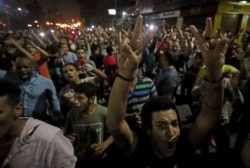Dramatic changes jolted the Arab world in 2019, as veteran rulers were forced to step down after popular protests. Public dissent threatened to destabilize governments with strong ties to Iran in both Iraq and Lebanon. Chaos and instability continued to plague Arab Spring losers Libya, Syria and Yemen.
Some observers are calling 2019 protest movements the second wave of the "Arab Spring," which began in 2011, sweeping away veteran leaders in Tunisia, Egypt and Libya, while igniting lengthy civil wars in Syria, Yemen, and Libya. In 2019, veteran leaders fell in Sudan and Algeria, while prime ministers were forced to resign in Lebanon and Iraq.
Popular protest movements in both Algeria and Sudan were covered by Arab media, causing a ripple effect in other parts of the region, capturing the imagination and enthusiasm of a large and growing population of young people. Many Arab observers have pointed out that large crowds of young people have spearheaded the movements that forced ailing Algerian President Abdelaziz Bouteflika to step down in April, and Sudanese President Oman Hassan al-Bashir to step down in June.
Efforts to stir up a popular revolt in Egypt against President Abdel Fattah el-Sissi did not appear to capture the public's imagination, however, despite accusations of corruption by an unknown businessman on social media. Egyptian media claimed the banned Muslim Brotherhood group and its allies, Turkey and Qatar, were behind the attempt, which quickly fizzled.
Egyptian political sociologist Said Sadek tells VOA that "this new phase of the Arab Spring adds to the existing instability in countries that went through the first phase, including Libya, Yemen and Syria." He blames the instability on "petro-dollars being used to buy arms in regional wars that are long and unresolved."
Sadek is more optimistic about Egypt, however, which he says has "improved its status in fighting terrorism" and has "fallen from 9 to 11 on the global terrorism index." The economy in Egypt also has improved considerably since the government began making structural reforms in 2015.
Tunisia underwent change, as well, with Tunisians electing a new president after ailing President Baji Caid Essebsi died of a heart attack on July 25. Voters chose a relative outsider after high-profile candidates like Prime Minister Youssef Chahed and the Muslim Brotherhood's choice for president, Abdelfattah Mourou, failed to win popular support.
Khattar Abou Diab, who teaches political science at the University of Paris, tells VOA that efforts to refashion the Middle East began under former U.S. president George W. Bush and his national security adviser, and later secretary of state, Condoleeza Rice. Attempts at change and reform, though, were deterred when Islamists tried to hijack the popular movements that began in 2011 in Egypt, Libya, Syria and Yemen.
"The world," he says, "began to talk about a new Middle East with Condoleezza Rice in Iraq in 2003," and her catch phrase "constructive chaos."
"Unfortunately," he argues, "Islamism began its ascent across the Arab world" — rather than constructive change. "Today, Islamism is still fighting to make a comeback."
"This time around," Abou Diab argues, "[the Arab world] is starting to focus more on national awakenings, and this is what we've been seeing in Sudan, Algeria, and more recently Iraq and Lebanon." "People," he insists, "are interested in saving their countries [and not in ideology]."
The current 2019 round of the pan-Arab protest movement appeared to reach momentum when protesters in both Iraq and Lebanon began to focus their ire on the outside interference of regional Shi'ite powerbroker Iran.
Brutal behavior by pro-Iranian Shi'ite militias galvanized public support for protests in many Shi'i'te majority regions of Iraq. Angry protesters ransacked Shi'ite militia offices and attacked Iranian consulates in the cities of Karbala and Najaf, setting fire to one and ransacking another.
Shi'ite communities in both Iraq and Lebanon, nevertheless, remain divided over whether to support the protest movements or traditional Shi'ite politicians and political movements.
Paul Sullivan, a professor at the U.S. government-funded National Defense University, says, "it is hard to tell where protests will lead [because they] are organic and fluid [and] even the leadership is unclear in some instances. Lebanon could get more violent. Algeria could go off the rails ... and Iraq could get very violent, especially as Iran-backed groups try to put a lid on things."
Even inside Iran, citizens frustrated by the economic pain of U.S. sanctions hit the streets to try to dislodge their increasingly unpopular Islamic Republic, after watching protests taking place in Iraq and Lebanon. The government, however, responded with the full range of its repressive tools to regain the upper hand, stifling a nascent revolt.
Theodore Karasik, a Washington-based Middle East analyst, tells VOA that 2019 "has been a transformative year for the region for the worse, because of the many regional actors who are taking advantage of the crises in Syria, Lebanon, Yemen and Libya."
"This year is more significant," he argues, "because of the uprisings against confessional systems, which go to the heart of Iran's rationale. "This issue will have an [even] greater impact in 2020."








